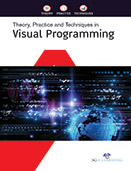Computer Science

The field of visual programming has been active since 1969, and many different systems have been built to both create and visualize computer programs. When many think of visual programming languages, the immediate association is to Visual Basic, a Microsoft product. Visual basic is one among many emerging graphic user interfaces oriented toward programmers. Visual Basic is not only a programming language, but it also has a complete graphical development environment. Visual Basic has the ability to develop programs that can be used as a front end application to a database system, and serving as the user interface which collects input from the user and displays formatted output in an attractive format. Using Visual Basic’s tools, you can quickly translate an abstract idea into a program design which you can actually see on the screen. VB encourages you to experiment, revise, correct, and network your design until the project meets your requirements.
This book “Theory, Practice and Techniques in Visual Programming” shows how to use graphics to program computers, train programmers, enhance human-computer communications and improve productivity. It explores how to create EXE files, ActiveX controls, but it is primarily focused to develop Windows applications, and interface web database systems. This generation of Visual Basic continues the tradition of giving you a faster and easier way to create .NET framework-based applications. This book is an introduction to the ideas of computer programming within the context of the visual arts that also serves as a text for Processing, an open-source programming language designed for creating images, animation, and interactivity.